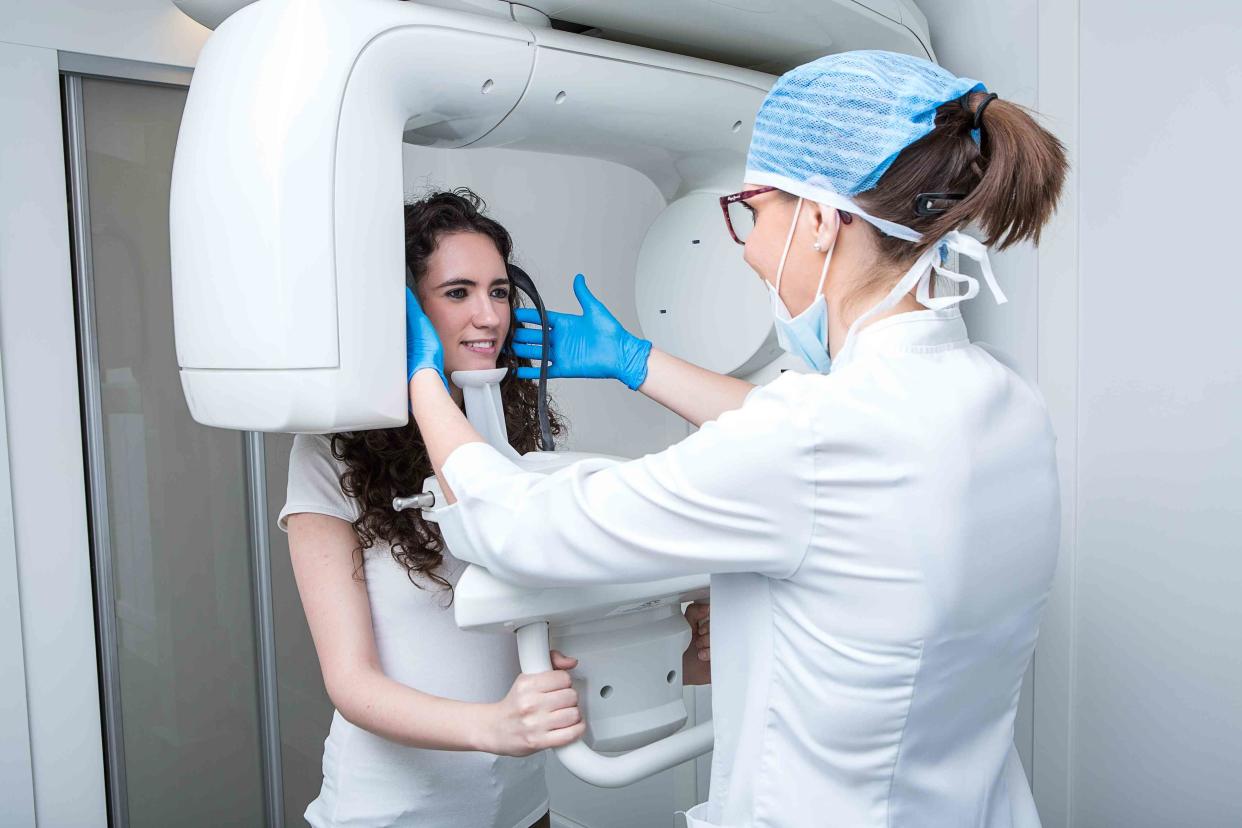Lead Aprons Are No Longer Necessary for Dental X-Rays

Juan Algar / Getty Images
Fact checked by Nick Blackmer
Key Takeaways
The American Dental Association no longer recommends wearing lead aprons or thyroid collars during dental X-rays, echoing guidance from other professional organizations.
A better understanding of X-ray risk and more advanced X-ray technologies led to this guidance change.
Lead vests could block the X-ray beam and prevent accurate imaging, which leads to more unnecessary X-rays.
Wearing a lead apron during a dental X-ray seems like a no-brainer, but new recommendations from the American Dental Association (ADA) say that these aprons and thyroid collars are no longer necessary, even for children and pregnant people.
Lead aprons have been standard practice in dentistry and health care in general since the 1950s, according to Sanjay M. Mallya, BDS, MDS, PhD, chair of oral and maxillofacial radiology at the UCLA School of Dentistry.
At the time, people feared that the health impact of radiation exposure from X-rays could pass down to their children. But after decades of research, there’s no evidence to confirm this concern.
“Over the years, what we’ve seen is that really has not held up in human populations. And from extensive studies, we now know that there are no hereditary risks from exposure to radiation in humans,” Mallya said.
The ADA isn’t the first major association to recommend discontinuing the use of lead aprons. The American Association of Physicists in Medicine shared a similar position in 2019.
“In 2003, the National Commission on Radiation Protection and Measurement concluded that lead aprons provide minimal benefit in dental imaging procedures,” Purnima Kumar, DDS, PhD, chair of the ADA Council on Scientific Affairs, told Verywell in an email. “While the ADA report is new, along with the recommendation to discontinue the use of thyroid collars, this is a topic that has long been studied and supported by leading radiation protection organizations.”
Is It Safe to Ditch the Lead Aprons During X-Rays?
Scientists know more about radiation now, but X-ray technology has also advanced. Digital X-ray equipment uses rectangular collimation, which restricts the beam size to just the area being examined. This can also reduce unnecessary radiation exposure during a dental X-ray.
Most dental offices have switched to digital X-rays, but Mallya said even if your office still uses old-school film, which has slightly higher amounts of radiation, you don’t need to worry because radiation from dental imaging is “very small.”
Wearing a lead apron or thyroid collar can actually “block the primary X-ray beam,” which means more X-rays might need to be taken, according to Kumar.
“Unnecessary X-rays are exactly what we want to avoid. These items can also potentially interfere with automatic exposure control settings in imaging systems, which may increase a patient’s radiation exposure,” Kumar said.
It might still take a while for patients to be comfortable getting a dental X-ray without the expected protection, so some experts say providers can still offer a lead apron for those who want to wear it.
“If the patient has any anxiety, it can affect the X-ray. For example, it can lead to patient motion, which can lead to more uptakes of the images,” Ahmed Abdelkarim, BDS, MSc, MSD, a clinical assistant professor of oral and maxillofacial radiology at The Ohio State University, told Verywell.
Providers who work with X-rays are still encouraged to stand behind barriers or wear lead aprons because they don’t get any benefit from the exposure, Abdelkarim added.
Depending on where you live, you might still be required to wear a lead apron during your next dental X-ray. Oregon stopped requiring lead aprons during dental X-rays in 2016, but many states still require these lead aprons by law. The guidelines from professional medical organizations are simply recommendations, and it could take a while for states to change their laws.
Do Pregnant People Really Not Need to Worry?
The new ADA recommendations also apply to pregnant people, but many providers anticipate that they will be hesitant to get an X-ray without using a lead shield to protect the fetus.
Mallya said the risk is low for pregnant people, and the radiation exposure is similar to the amount they would get during a 5-hour flight.
“When you take an airline flight, you’re at an altitude, so you get exposed to more cosmic radiation, more ionizing radiation, very much like X-rays,” Mallya said.
Putting off a dental X-ray during pregnancy isn’t recommended because it could potentially help identify an infected tooth that needs to be removed.
“If [the infection] spreads through the body, it could be worse for the fetus than the low risk from that dental X-ray,” Mallya said.
Read Next: Why Dental X-Rays Are Necessary
What This Means For You
Wearing a lead apron during a dental X-ray has been standard practice for years, but it's no longer recommended. Because of technological advances, radiation exposure from a dental X-ray is minimal. A lead apron might actually block X-ray beams and prevent the technician from capturing the images accurately.
Read the original article on Verywell Health.

